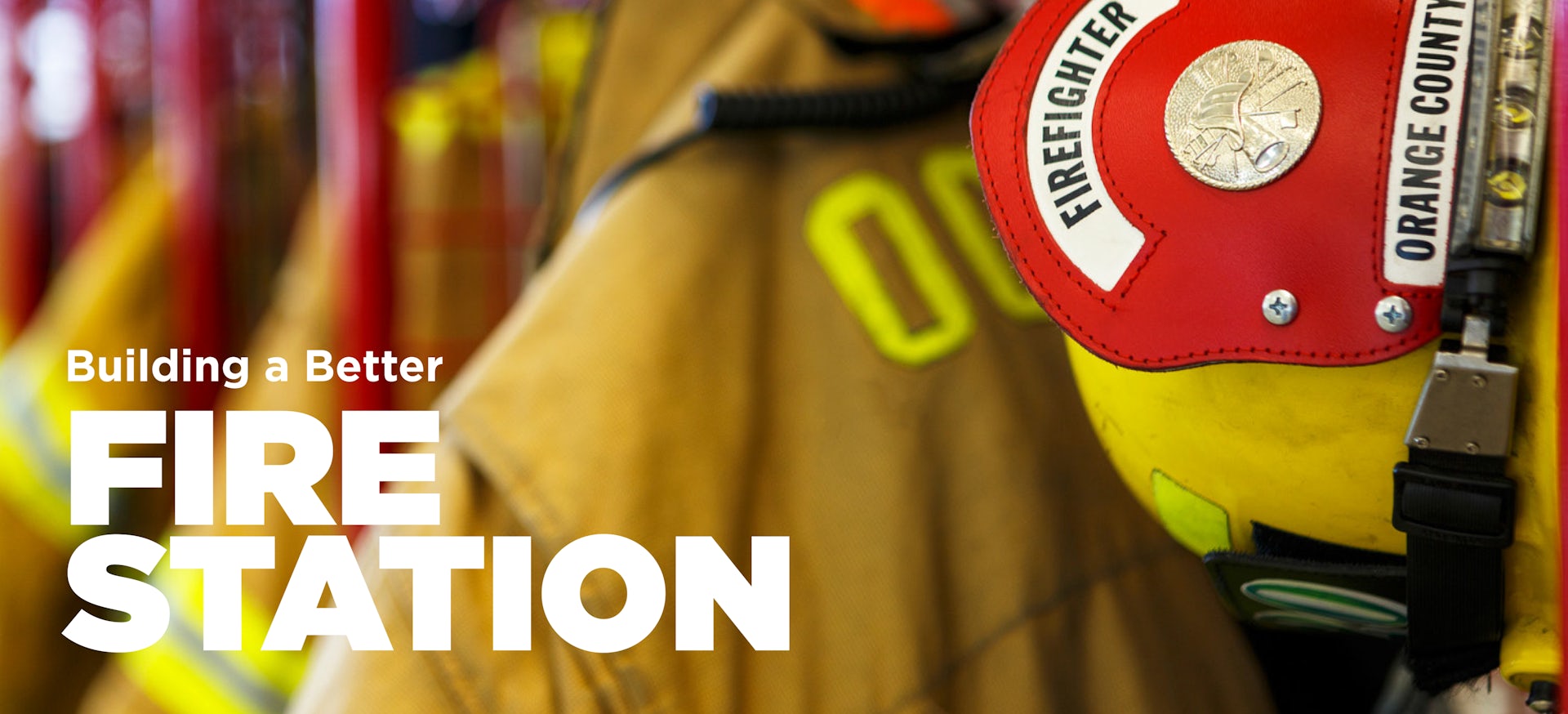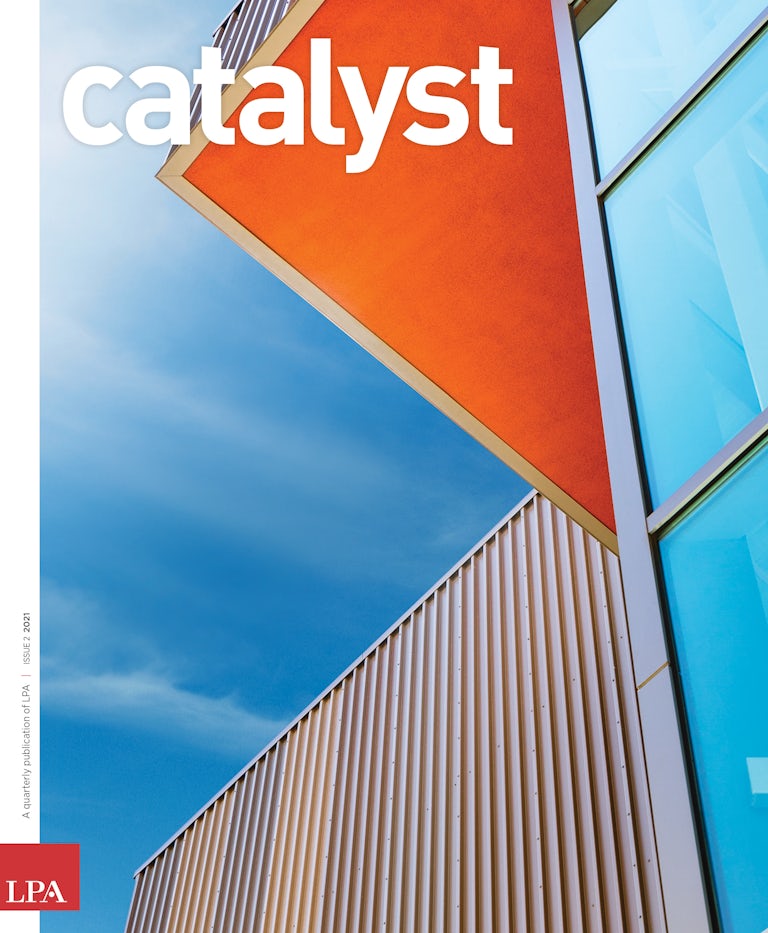The classical version of a fire station, a red brick-clad symbol of the community with fire poles and Dalmatians, may be one of our most beloved local institutions. But as communities change, new challenges arise, and these civic cornerstones start showing their age, it’s clear these facilities need to evolve to stay true to their mission.
“Society’s changing, firefighting is changing, and technology is changing,” says Daniel Wang, a structural engineer at LPA. “The question now is: Can you design a fire station today that’s truly future-proof?”
Building a Better Fire Station
A holistic, ‘kit of parts’ approach to modern fire station design results in future-proof facilities that work better for firefighters and the community.

Many communities contain aging public safety infrastructure that doesn’t meet current operational, safety and building and safety code standards. In the event of a disaster, fire stations must remain operational, but many facilities designed in the 1950s, ‘60s and ‘70s are simply not up to the task. At the same time, they don’t meet the standards of technology and wellness necessary to support today’s firefighters.

As communities plan for future services and infrastructure, it’s time to rethink how and why stations are built and how they function. A cost-effective update should go beyond repairs and aesthetics, recognizing the different functions and roles of a modern facility. New designs can develop facilities that provide a higher level of safety, security and protection for the community. Among the questions communities face are these: How can we build for a community more cost effectively? How could we do this for a community faster?

A holistic design approach can address many community goals, in addition to the efficiency and effectiveness of the public safety tasks. Smart decisions about structure design, living facilities, state-of-the-art technology and turnout spaces for storing and cleaning firefighters’ smoke- and chemical-contaminated gear can extend the value and life of a facility and promote firefighters’ health and wellness. A modular design philosophy that explores every aspect of design allows development of buildings that can serve multiple needs.
“We’ve got this ‘kit of parts’ that can really start to efficiently address what it takes to build what a community needs,” says LPA Director of Civic + Cultural Jeremy Hart. “We can plug in management office components, plan-check departments or community health services — all these different parts and pieces that are built around the base of the chassis, which is the apparatus bay.”

New design ideas and approaches offer fire stations greater community presence than traditional facilities. Creative landscaping, open façades and additional spaces that can double as meeting rooms or voting centers help stations play a more regular and varied role in citizens’ lives.
As communities plan for future services and infrastructure, it's time to rethink how and why stations are built and how they function.
LPA’s design for the new 8,500-square-foot Cathedral City Fire Department station, near Palm Springs, California, is set on a landscaped lot with a public dog park.
“The stations that are more impactful have a certain openness,” says Tracey Powl, a project manager at LPA. “There’s a lot of city pride in these spaces.” Changing the programming to allow for a more front-and-center approach to the street can make residents more comfortable with a facility and change perceptions, as well as expand the functionality.

The community inside these buildings also needs attention. In traditional fire stations, the living space leans toward dorm-style layouts, with a shared common area and showers like those in a gym. Updated projects offer large kitchens and comfortable living quarters for the staff. Station 20, an LPA project in Irvine, California, boasts bike storage along with a BBQ patio. Firefighters’ health is a primary concern. In recent years, research has confirmed the existence of carcinogens associated with fighting fires. This knowledge makes it vital to design support spaces where firefighters can clean their smoke- and chemical-contaminated gear when they return from calls. “Older facilities don’t address these issues,” Hart says.

Interior designs also must be modernized to reflect the more inclusive firefighting community. New stations boast improved kitchens; personal rooms/sleeping quarters; single-occupant, gender-neutral shower and bathroom compartments; and ADA-compliant facilities. As the profession has diversified along multiple fronts, it’s important to not lose focus on the human aspect of design, providing more privacy and more comfort for fire crews.
“Fire stations built in the ‘50s didn’t really take women into account, for instance,” Hart says. “Today’s stations have facilities that respond to varying needs to accommodate a more equitable and inclusive firefighting force.”
The inner workings of a station are not all that’s changing. Many older fire stations were built of wood frames due to the speed and easy access to materials, however, other methods of construction can provide a longevity and a resiliency that is worth consideration. Pre-Engineered Metal Building Frames (PEMB) is one method that can save time and money.
“You need to look at the lifecycle cost of the facility,” Wang says.
LPA has been building stations with a wide variety of construction techniques and materials, including concrete, wood studs and pre-engineered steel. This “kit of parts” approach results in stations that function more modularly and can be added onto like a set of Lego blocks. “Depending on the driving factor of the project — speed or cost or resiliency or longevity of the structure — there’s a different way to build it that’s right for that specific project,” Hart says. “Experience can help lead to the appropriate choice for that project.”

The city of Buena Park, California, saved more than $1 million on its new Station 61 because of its pre-engineered steel frame, which enabled the project to come in under budget and ahead of schedule. Despite the rather sizable list of features, which included 13 crew dormitories, a training room and administrative facilities including numerous offices, the station was completed in less time with fewer complications. The process reduced the station’s downtime, an important consideration for a station that is one of the busiest in Orange County. The station was also designed as a rally and fueling point for engines responding to wildfires.

Using more systematized design approaches is a small gesture that can greatly improve sustainability, Wang says. “Resilient material and resilient design mean there’s inherent flexibility,” he says. “You can add in either direction and not impact the structural integrity of the system.”
Steel also helps defend against nature’s disasters. The rethink of a station’s role comes in an era of increased wildfire threats, especially in growing communities in or near rural areas or the wildland-urban interface, a key consideration in how buildings are sited and constructed.
“I don’t think anybody can deny how climate change has impacted wildfire activity across California, and created more weather-related risks everywhere,” Hart says. “Building an efficient and robust station that takes this threat seriously can go a long way toward protecting our communities.”

We can plug in management office components, plan-check departments, or community health services - all these different parts and pieces that are built around the base of the chassis, which is the apparatus bay.
Inevitably, firefighting will continue to evolve. Safety gear, or our understanding of it, may shift. (Old stations often don’t have turnout rooms, which help firefighters returning from the field safely remove smoke- and chemical-contaminated gear.) Communications gear, which can account for up to 10 percent of a finished project’s budget, will likely change. And stations may grow into new roles, holding more engines, crew, or even administrative offices. This all suggests an investment in more flexible, modularized construction pays dividends over time.
This is infrastructure that needs reinvestment, and reimagining, to face current and future challenges. In many cases, a wholesale replacement might make sense because so much must be updated. Rebuilding or building a new fire station should ultimately be about building a better fire station.
“When we talk about essential services, everyone focuses on the structure you’re upgrading,” Hart says. “But there’s more than that. It’s also about doing it in a way that retrofits all the systems required to be operational.”

For years, LPA has worked closely with the Orange County Fire Authority (OCFA) to develop a set of standards for the rapid retrofitting of facilities, which has been used for dozens of new and upgraded stations.
The relationship dates to 2002, when LPA first worked with OCFA to develop a Development Guide and a prototype fire station to guide future development. The Development Guide was created with modules that flex the size of the station based upon the number of apparatus bays. The quantity of the apparatus bays informs the different elements, including the quantity of equipment, the number of dorms required and the size of the kitchen, day room and fitness room. The Development Guide also offers a variety of office plug-ins to the prototype station, from a standard office unit to a Battalion Chief’s office. There are even plug-in components for plan check services and a health clinic, as needed by the community.
“This long-term relationship has allowed us to explore more efficient ways to design resiliency and flexibility into stations,” says LPA Director of Civic + Cultural Jeremy Hart. “We’ve been able to focus on how design can help very specific functions within a department.”















